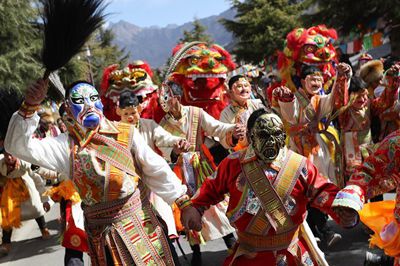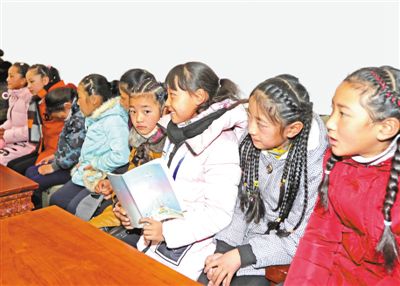|
II. Democratic Reform and Regional Ethnic Autonomy in Tibet
12. What kind of social system was in force under the Dalai Lama in old Tibet? Was the old Tibet really the last "Shangri-La"?
A: There are people from the West who compare Tibet to the Shangri-La of The Lost Horizon, written by British novelist James Hilton in 1933, likening this region to a utopian Land of Peach Blossoms. They find it inconceivable that, as late as the 1950s, Tibet still functioned as a feudal serfdom system under a theocratic dictatorship, in a manner similar to the integration of religion and politics in Medieval Europe.
Tibet's feudal serfdom, as practiced in early feudal society, and carrying with it many traces of slavery, was an exploitative, inhuman system.
In terms of the nature of the political system in force in Tibet, its distinguishing features were the combination of religious authority and political power. The Dalai Lama was both the religious and political head of Tibet. The local government was composed of the most high-ranking monks and nobles, who represented the interests of the serf-owning class. Serfs and slaves, then accounting for 95 percent of the Tibetan population, were owned by the three estate-holders (officialdom, monasteries and nobles) for life, and, as such, had no vestige of personal freedom. The feudal lords could beat ,abuse, punish, sell, present as gifts, imprison and even kill slaves with impunity. When slaves met for the first time, they did not exchange their own names, but those of their masters. According to Tibet's regional code, society was arbitrarily divided into classed and ranks, and people were divided into three social classes - upper, middle and lower-each class having its own further subdivision into these three ranks. According to the law regarding compensation for the life of a murdered person, it was stipulated that "people are classified into different ranks and classes, and the value of any one life is estimated accordingly." The value of a person from the upper echelons, for example, a prince or Living Buddha, was equal to the price of gold of his body weight, while that of a person of lowest class could be equal to the price of a straw rope. Tibet's judicial system meted out horrifying punishments, such as gouging out the eyes, cutting off the noses or ears, and amputating the hands and feet of offenders.
Regarding the economy, the three major estate-holders, who accounted for less than 5 percent of Tibet's total population, were almost exclusive owners of arable land and grassland, forest, and livestock. Serfs and slaves, on the other hand, who made up over 95 percent of the total population, were deprived of all means of production. Serfs had no land or freedom, and were completely dependent on estate-holders for their material survival. Masters controlled the birth, death and marriage rights of their serfs, so when serfs married, agreement between their masters had first to be obtained. Children of serfs were registered the day they were born and designated as slaves for life.
Regarding societal conditions under such a system, Tibet's economy and culture remained stagnant for centuries, and its population declined from several million at its peak to only 1 million in 1951. Epidemic diseases often spread unchecked, and life expectancy was only 35.5 years. The Tibetan ethnic group, having formerly created a splendid culture, had an illiteracy rate of over 90 percent. Before the democratic reform in 1959, out of Lhasa's 37,000 population, 4,000 to 5,000 were beggars, while in Xigaze, with a population of less than 10,000, there were 2,000 to 3,000 beggars. Homeless people often died on the street.
Historical records indicate that the basic human rights of the people in old Tibet were non-existent. The Dalai Lama, now in exile, was the religious and political ruler of old Tibet, and therefore responsible for the sufferings of the people. |
- Home
- News |Tibet |Exclusive |China |World |Other Tibetan-Inhabited Area |Tibet through the Eyes of Foreigners |Related News
- Documents |White Papers |Others
- Photo |Politics |Economy & Society |Culture & Religion |Human & Nature |Beautiful Tibet |Other Tibetan-Inhabited Area |Exchanges |Related
- Video |News |Documentary |Micro-Video |Entertainment
- Art
- Tourism
- In Focus
- About Tibet






